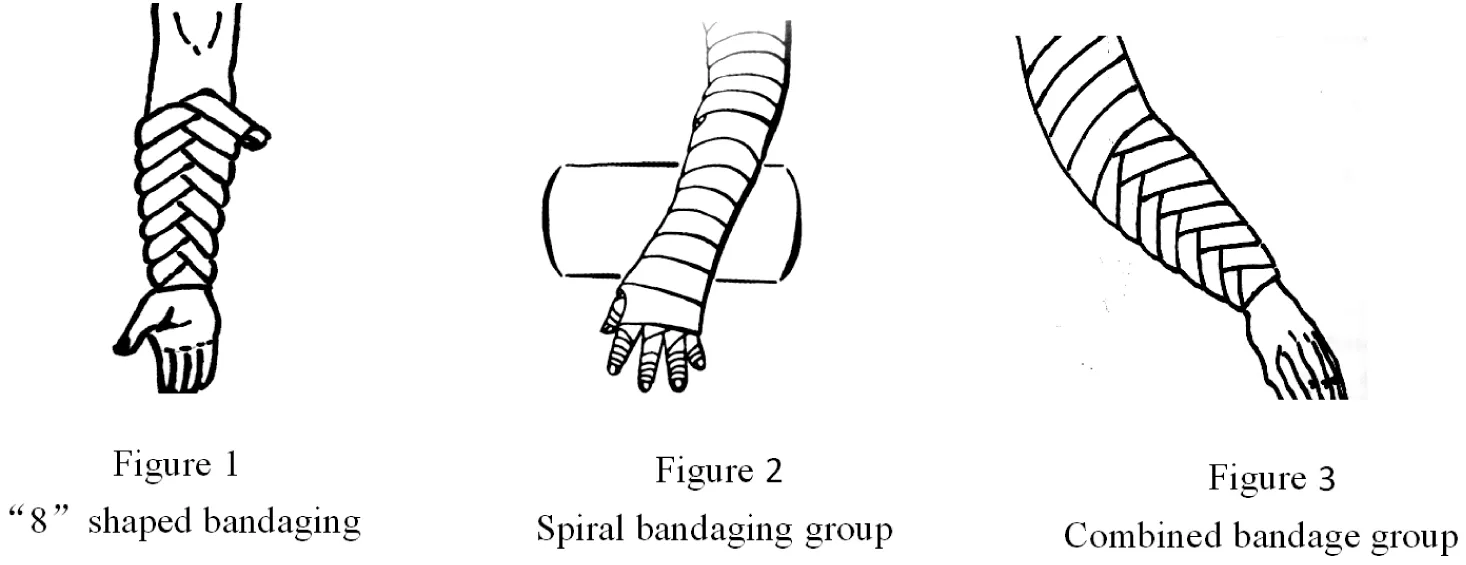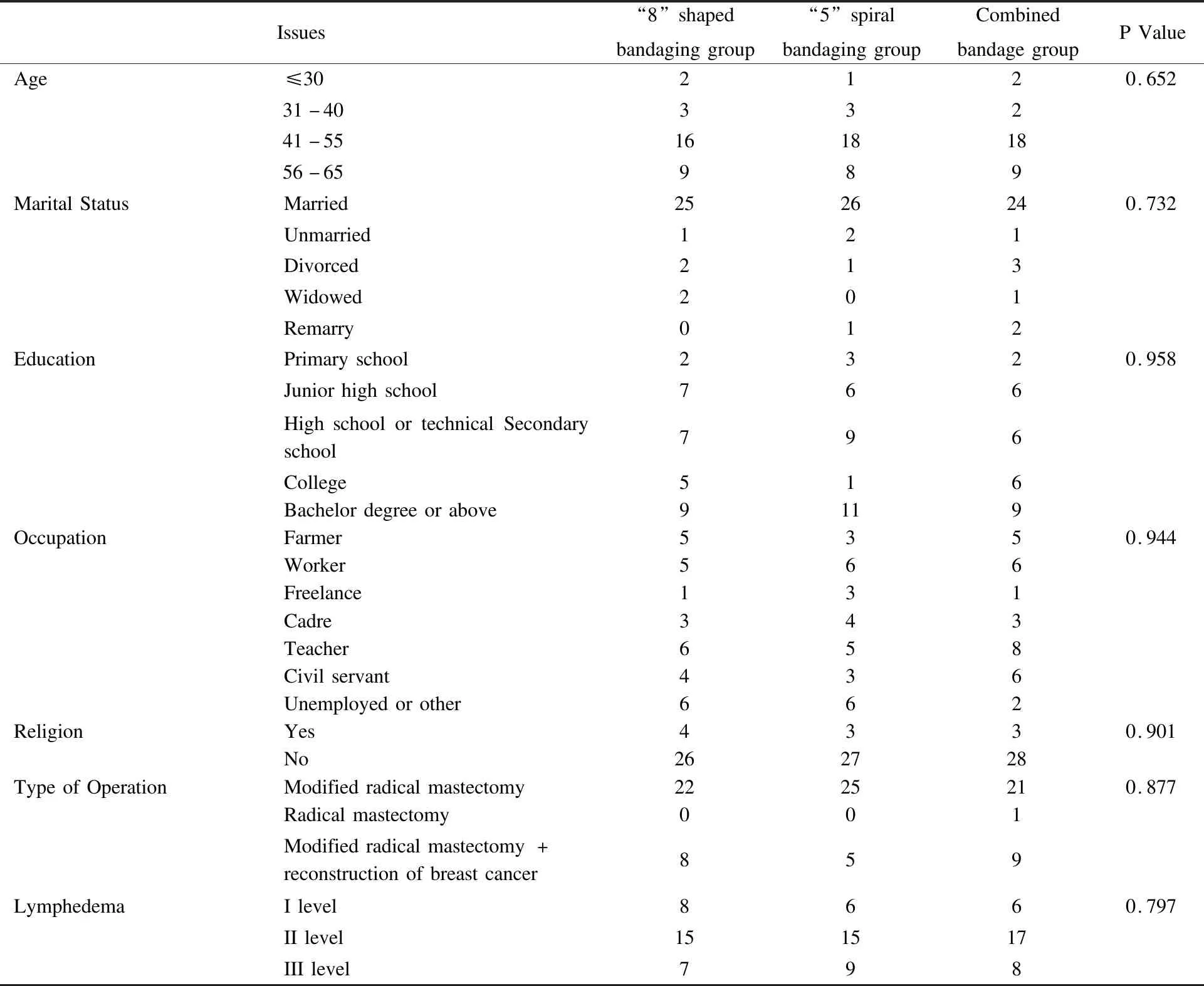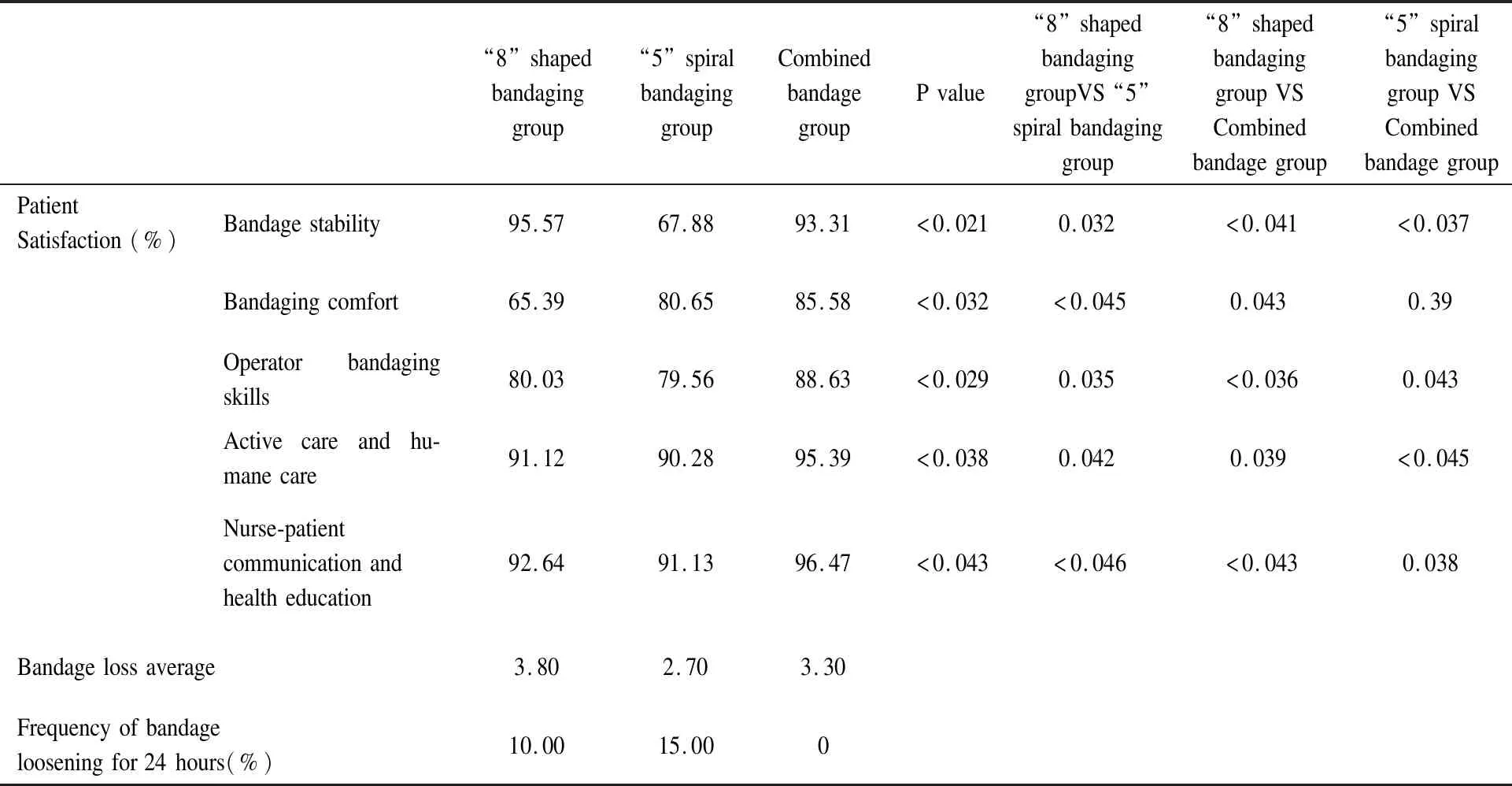Study on the correlation between bandage bandage and pressure therapy of lymphedema
2020-11-04,,,,,
, , , , ,
(1.Department of Nursing ;3.Department of Health Education;4.Department of Gynecology Clinic,Affiliated Hospital of Integrated Traditional Chinese and Western Medicine,Nanjing University of Chinese Medicine,Nanjing,Jiangsu,210028;2.Department of Nursing,The First People's Hospital of Lianyungang,Lianyungang,Jiangsu,222002;5.Longhua District of Hainan people's Hospital,Haikou,Hainan,570102)
ABSTRACT:To explore the effects of bandage technology and pressure therapy in breast cancer with lymphedema.Methods A total of 91 patients,with breast cancer-related lymphedema and hospitalized in a third-class hospital in Jiangsu Province from May to December,2018,were selected and sequenced in class “ABC” in the order of entry.The patients in class “A” were enrolled in “8” shaped bandaging group.The patients in class “B” were enrolled in “5” spiral bandaging group.The patients in class “C” were enrolled in combined bandage group.The primary outcome was the degree of limb swelling used by multiple-frequency bioelectrical impedance analysis.Secondary outcomes were the amount of bandage losses,counting 24-hour bandage loose occurrences and patients satisfaction.All outcomes were evaluated both before and after treatment.Results After treatment,there was a significant difference in the regression of limb swelling in all three groups (P<0.05).However,the largest amplitude of regression was observed in combined bandage group (limb circumference ratio:53% and tissue water ratio:68%).Although “8” bandaging group had large material,bandage cost and minimum comfort,the bandage has good stability and no case of 24-hour bandage loose occurrences was found in this group.The “5” partial binding group had an advantage in the amount of bandage losses and comfort level,but among which 3 patients had the phenomenon of loose bandage at the joint.The combined bandage group had the best therapeutic effect in limb swelling and patients satisfaction (P<0.05).Conclusion The combined bandage group significantly decreased the degree of limb swelling and 24-hour bandage loose occurrences.Importantly,this treatment improved the degree of patients’ satisfaction.The treatment of “8” shaped bandaging combined with spiral bandaging is worthy of clinical promotion.
KEY WORDS:bandage pressure bandage;lymphedema;complex decongestion therapy;correlation study
Introduction
Lymphedema ranks 11 in all global common chronic diseases.In 1983,Casley Smith,the chairman of International Society of lymphology,estimated that about 140 millions people all around the world suffered from various kinds of lymphedema,45 millions of which were suffered from lymphedema related to body[1].Complex decongestion therapy (CDT) is an effective,safe and versatile lymphedema physical treatment that actively promoted by China and other countries recently,including manual lymph drainage,skin care,pressure bandage,functional training[2-4].Pressure bandage is an essential part in CDT that could directly affect the treatment effect of CDT[5-6].However,the pressure bandage mainly relies on low-pressure bandage to realize.The basic bandage has two types:“8” binding method and “5” partial binding method.The bandage technology also has two types:single “8” or “5” binding method or united binding method.This research is aiming to find which type is more acceptable for patients and more suitable for CDT treatment,whatever the binding method or the binding technology.We develop comparative exploration regarding the above goal and report as follows.
Methods
Participants
A total of 91 patients with lymphedema were selected from January to December,2018.Inclusion criteria were ① female;age of 18 to 65 years;② the first pathologist diagnosis of breast cancer with lymph node dissection;normal liver,kidney and other laboratory tests,no other tumors;③ no trauma history and normal limb function before operation;④volunteer to participate in clinical research and can actively cooperate,sign informed consent.Exclusion criteria were ① limb paralysis;② patients with allergies to bandages;③psychopath and uncooperative patient.
Edema occurred in 15 cases of left upper limb and 47 cases of right upper limb.6 patients had mild swelling,30 patients had moderate swelling,and 26 patients had severe swelling.They were randomly divided into three groups,"8" shaped bandaging group,spiral wrapping group and joint dressing group.The study was approved by the ethics committee of the Affiliated Hospital of Integrated Traditional Chinese and Western Medicine.Participants provided written informed consent prior to enrollment.Lymphatic therapists are all nurses who have participated in special training on lymphedema and passed the examination and obtained the training certificate within one year after completion.
Treatment methods
All the patients were given the manual lymphatic drainage,which was referred to the comprehensive therapy which was created by Foldi et al.It There are four methods which included the fixed circle method,the pumping method,the shovel method,and the rotation method on the edema areas (chest and back,upper arm,forearm,palm,finger) followed by the drainage massage.According to the lymphatic pathway,the lymph fluid was gradually pushed to the functional normal lymph node group.After the end of the drainage,a low-elastic bandage was immediately used to apply a gradient pressure dressing to the affected limbs.The study groups were all used a low-elastic bandage (Lohm ann Rauscher or Hartm ann,Germany) for gradient pressure bandaging of the affected limb.
Interventions used in the trials
“8”shapedbandaginggroup
“8” shaped bandaging group was defined as a method of cross-wrapping in an “8”shape (Figure 1).There are several requirements:① From the telecentric end to the proximal end;②The next line of bandage covered the upper layer with a width of nearly 1/2,and a newly opened bandage must be covered the 50cm portion of the tail of the previous bandage;③Each “8” shaped crossing angle was in the same straight line;④After a roll of bandage was over,the end of the bandage was fixed with two tapes.
Spiralbandaginggroup
We moved the bandage up in the spiral direction,the bandage was layer by layer from the palm ,forearm ,upper arm(Figure 2).The latter layer of bandage was required to cover the 50% width of the previous.After a roll of bandage was over,the end of the bandage was fixed with two tapes.
Combinedbandagegroup
We use the"8" shaped bandaging method to wrap up the hand,forearm,elbow joint.Above the elbow joint ,we use the spiral bandaging method(Figure 3).Banding elements were the same to the above two methods of bandaging.

Evaluations
Degreeoflimbswellingfrombeforetoaftertreatment
The degree was expressed by limb circumference ratio and tissue moisture ratio.We used Multiple-frequency bio-electrical impedance analysis to detect the degree of edema in healthy limbs and affected limbs,that is to say,the extra cellular fluid content.
TheamountofbandagelossesandCounting24-hourbandagelooseoccurrences
The amount of bandage losses:After each completion of the pressure treatment,the amount of bandage losses were registered by the lymphatic therapists and patients gathered the total usage of bandages when they finished the whole course of treatments.
Counting 24-hour loose bandage occurrences:The lymphatic therapists formed We Chat group which included patients,and instructed the patient on loose indications of bandages after each treatment.Once the bandage was loose or the end of the bandage at the bandage joint was slipped within 24 hours,patients should send the photos to We Chat group.Entered for registration after the lymphatic therapists confirmed.
Degreeofsatisfaction
We adopted a self-made satisfaction scale?which includes?bandaging stability,bandaging comfort,bandaging skills,active service and humanistic care,nursing communication and health education.There are 10 questions in each part,and the full mark is 100 points,which are rated as good (10 points),good (8 points),good (6 points),average (4 points) and poor (2 points).The higher of the total score,the dressing effect is better satisfied.The satisfaction questionnaire is in the charge of the nurse interns.It is handed out and collected at the end of treatment,and the average qualified rate of each aspect is calculated.The reliability and validity of the questionnaire were tested to be greater than 0.75.
Statisticalanalyses
Analyses were performed with the SPSS Statistical Software 19.0.The ordinal date was analyzed by two Independent Sample Test and measurement data were tested by two independent sample t test.P<0.05 was considered statistically significant.
Results
There were no significant differences in age,marital status,education,occupation,religion,surgical type,and lymphedema grading among the three groups (Table 1),and the data between the groups were comparable.This study meets the requirements of the Helsinki Declaration.

Table 1 Comparison of baseline data of lymphedema after breast cancer surgery
As indicated in Table 2,the three groups of bandaging techniques in this study all have a certain therapeutic effect (the "8" bandaging group,the circumference ratio before and after treatment is reduced by 5.65%,and the tissue water ratio is reduced by 3.93%;the "5" group is divided into bandaging group,before and after treatment.The diameter ratio decreased by 7.24% and the tissue water ratio decreased by 3.23%;the combined bandaging group,the circumference ratio before and after treatment decreased by 8.11%,and the tissue water ratio decreased by 8.22%).Obviously,the combined bandaging group has the best treatment effect (P<0.05)。

Table 2 Comparison of limb swelling before and after treatment
Table 3 shown that all three groups of bandaging techniques in this study have certain therapeutic effects.Obviously,the combined bandaging group had the best therapeutic effect (P<0.05).Combined with the analysis in table 2,patients in the "8" bandaging group thought that the score of comfort bandaging was 65.39,among which 2 patients removed the bandage by themselves;patients in the “5” sub-package group scored 67.88 points for the degree of bandage stability,and the operator's skill score was 79.56 points,among which 3 patients had the phenomenon of loose bandage at the joint.Obviously,the effect of CDT treatment in these two groups was lower than that in the combined bandaging group.

Table 3 Comparison of patient satisfaction,loss of bandage and 24-hour loose rate of bandage
Discussion
The bandage binding technique is closely related to the effects of lymphedema pressure treatment.As shown in Figure 1,although three binding techniques all have treatment effects in some extent (the ratio of the peri-diameter before the treatment to that after the treatment was reduced 5.65% in “8” binding group;the ratio of the peri-diameter before the treatment to that after the treatment was reduced 7.24% in “5” binding group;the ratio of the peri-diameter before the treatment to that after the treatment was reduced 8.22% in united binding group),the united binding group is the most effective obviously (P<0.05).Combined with Figure 2,we find that the comfort grade after bandage binding of patients in “8” binding group is 65.39 and have two incidents that the patients removed the bandage by themselves;while the grade regarding the extent of bandage stability of patients in “5” binding group is 67.88,the grade about the operators’ skills is 79.56,and have three patients who loosed bandages at joints.Obviously,the treatment effect of the patients in these two groups is not better than that of the united binding group.However,it is worth mentioning that the relationship between binding technique and treatment effects is also decided by the proficiency of operators.As a result,the operators in this research are limited in “the nurses that participated in professional training of lymphedema,passed the theories and operation exams,and got the certificate within 1 year”.Besides that,the operational ability of the operators is one of the interference factors.Due to the limitation of the number of people studied in this research,the project design is supercilious.Hopefully,with the increase of samples,the research becomes more comprehensive in this field.
The united binding method could enhance the degree of satisfaction.As shown in Figure 2,“8” binding method is stable,not easy to loosen,fixing rigidly,and never fall off.However,its pressure is larger,costs more material (the average bandage using is around 3.8 rounds in upper limbs) and as a result,the patients have more economic burden and low degrees of comfort and satisfaction;“5” binding method saves material (the average bandage using is around 2,7 rounds in upper limbs).However,it is not stable,easy to loosen,and the binding technique is easily affected by the operators experience.The curative effects are easily affected if the method is used by elementary lymphedema therapists.The patients are doubtful to the operators’ skills and have low degree of satisfaction;united binding method,which utilize “8” binding method for limb joints and body parts where the circumferential diameters are slightly narrow,and utilize “5” binding method for the body parts where the diameters are large,is distinctive.This technique is stable,not easy to loosen and saves material (the average bandages using is 3.3 rounds).The patients have high degree of comfort and satisfaction regarding this method and it is effective as well.
With the deepening of the medical research,the creative research on surgical dressing and medical equipment is developing as well.Adapting needs for nursing and accelerate treatment effects is one of the key factors.The propose of bandage binding technique is not only a proper utilization of basic binding techniques,but also a distinctive binding technique design regarding different characteristics of bodies that combines ergonomics.It is very good for the patients’ recovery.
